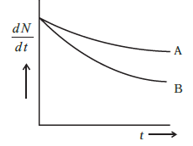
Which sample A or B has a shorter mean life?
Answer
496.5k+ views
Hint:Mean life, in radioactivity, average lifetime of all the nuclei of a particular unstable atomic species. This time interval may be thought of as the sum of the lifetimes of all the individual unstable nuclei in a sample, divided by the total number of unstable nuclei present.
Complete step-by-step solution:
The mean life of B is shorter than that of A
According to the Radioactive Decay Law states that the decay rate of a nucleus is given by the formula of
\[\dfrac{{dN}}{{dt}} = - \lambda N\]
Where,
\[\dfrac{{dN}}{{dt}}\] is the rate of decay of the nucleus with respect to time, \[\lambda \] is the decay rate constant of the nucleus and \[N\] is the number of nuclei present in the sample. As shown in the graph the X axis the decay rate and Y axis is the time of decay, now to point the decay rate constant in the graph we have to draw a slope on the curve of sample A and B like this

The slope of the A and B curve dedicates the decay rate constant of the sample A and B respectively. Now as for the mean life of the samples, the mean life formula is
\[\tau = \dfrac{1}{\lambda }\]
Where,\[\tau \]is the mean life and \[\lambda \] is the decay rate constant. So according to the diagram the mean life of A and B are given as
\[{\tau _A} = \dfrac{1}{{{\lambda _A}}},{\tau _B} = \dfrac{1}{{{\lambda _B}}}\]
\[{\lambda _A} < {\lambda _B}\]
\[{\tau _A} > {\tau _B}\]
Now as we can see in the above diagram (in the explanation), the value of decay rate constant of B and A is \[{\lambda _A} < {\lambda _B}\] (the flatter the curve the lesser is the slope therefore, the value of the slope of B is greater than A as the curve of B is greater than A) respectively. Hence, due to inverse proportionality the value of mean life of B is lesser than that of A.
Therefore, the mean life of B is shorter than that of A.
Note:We need to remember that radioactive decay (also known as nuclear decay, radioactivity, radioactive disintegration or nuclear disintegration) is the process by which an unstable atomic nucleus loses energy by radiation. A material containing unstable nuclei is considered radioactive.
Complete step-by-step solution:
The mean life of B is shorter than that of A
According to the Radioactive Decay Law states that the decay rate of a nucleus is given by the formula of
\[\dfrac{{dN}}{{dt}} = - \lambda N\]
Where,
\[\dfrac{{dN}}{{dt}}\] is the rate of decay of the nucleus with respect to time, \[\lambda \] is the decay rate constant of the nucleus and \[N\] is the number of nuclei present in the sample. As shown in the graph the X axis the decay rate and Y axis is the time of decay, now to point the decay rate constant in the graph we have to draw a slope on the curve of sample A and B like this

The slope of the A and B curve dedicates the decay rate constant of the sample A and B respectively. Now as for the mean life of the samples, the mean life formula is
\[\tau = \dfrac{1}{\lambda }\]
Where,\[\tau \]is the mean life and \[\lambda \] is the decay rate constant. So according to the diagram the mean life of A and B are given as
\[{\tau _A} = \dfrac{1}{{{\lambda _A}}},{\tau _B} = \dfrac{1}{{{\lambda _B}}}\]
\[{\lambda _A} < {\lambda _B}\]
\[{\tau _A} > {\tau _B}\]
Now as we can see in the above diagram (in the explanation), the value of decay rate constant of B and A is \[{\lambda _A} < {\lambda _B}\] (the flatter the curve the lesser is the slope therefore, the value of the slope of B is greater than A as the curve of B is greater than A) respectively. Hence, due to inverse proportionality the value of mean life of B is lesser than that of A.
Therefore, the mean life of B is shorter than that of A.
Note:We need to remember that radioactive decay (also known as nuclear decay, radioactivity, radioactive disintegration or nuclear disintegration) is the process by which an unstable atomic nucleus loses energy by radiation. A material containing unstable nuclei is considered radioactive.
Recently Updated Pages
Master Class 12 Business Studies: Engaging Questions & Answers for Success

Master Class 12 Economics: Engaging Questions & Answers for Success

Master Class 12 English: Engaging Questions & Answers for Success

Master Class 12 Maths: Engaging Questions & Answers for Success

Master Class 12 Social Science: Engaging Questions & Answers for Success

Master Class 12 Chemistry: Engaging Questions & Answers for Success

Trending doubts
What are the major means of transport Explain each class 12 social science CBSE

Which are the Top 10 Largest Countries of the World?

Draw a labelled sketch of the human eye class 12 physics CBSE

Explain sex determination in humans with line diag class 12 biology CBSE

The pH of the pancreatic juice is A 64 B 86 C 120 D class 12 biology CBSE

Explain sex determination in humans with the help of class 12 biology CBSE




